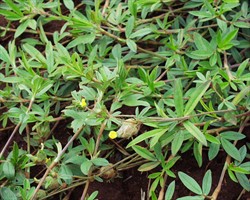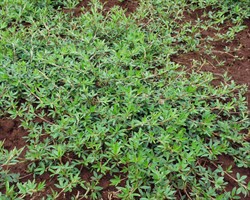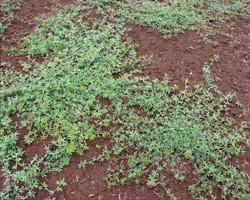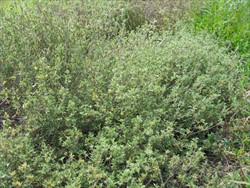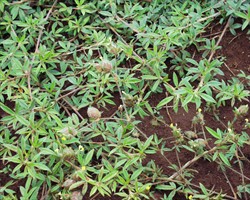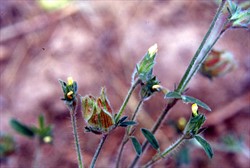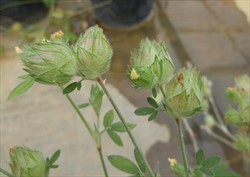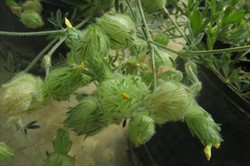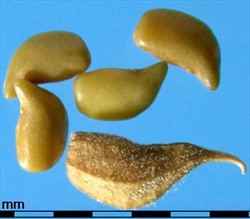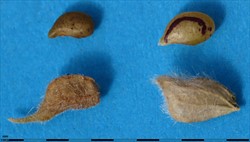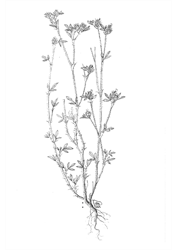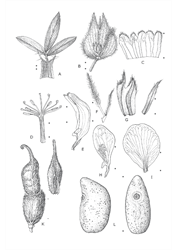Tropical Forages
None listed in GRIN.
Family: Fabaceae (alt. Leguminosae) subfamily: Faboideae tribe: Dalbergieae subtribe: Stylosanthinae.
A perennial, fine-stemmed, many-branched, and tap-rooted sub-shrub, prostrate to semi-erect, 20‒80 cm tall; stems and branches hairy-bristly. Leaves trifoliolate; petiole 1‒2 mm long, villous; leaflets lanceolate, 20‒55 mm long, 10‒19 mm wide, pubescent or glabrous, with 7‒10 pairs of veins. Inflorescence a terminal or axillary capitate spike, ovoid to almost spherical, 14‒18 mm × 10‒15 mm, with 10‒30 flowers; often several inflorescences in a cluster; bracts imbricate, unifoliate, elliptical-ovate, 10‒12 mm × 8‒9 mm, pubescent, with 11‒15 veins, green, mostly with some reddish colouration; flowers small, yellow (sometimes with beige toning) with obovoid, striated standard 4‒6 mm long; axis rudiment and 2 inner bracteoles present. Pod 2-articulated, reticulately nerved; oth articles usually fertile; the upper one glabrous, 3‒4 mm × 2.5‒3 mm, with a short, straight to uncinate beak; lower article villous and smaller. Seed yellow-brown, sometimes slightly mottled, to black. 470,000‒700,000 dehulled seeds per kg.
Similar species
Distinguished from by having more branched and finer stems, smaller and narrower leaflets and smaller, almost spherical inflorescences (1‒2 cm vs 6‒7 cm long).
English: macrocephala
Latin America: estilosantes (Brazil)
Native:
South America: Brazil (Bahia, Ceará, Distrito Federal, Espirito Santo, Goiás, Mato Grosso do Sul, Minas Gerais, Pará, Pernambuco, Piauí, Rio de Janeiro, Tocantins)
Forage
Used as forage in permanent pastures on low fertility acid soils.
Occurs in sub-humid and dryland savanna environments.
Soil requirements
Mostly found on sandy soils in savannas and heavier soils in the caatinga, with pH between 4 and 5 (rarely to 6), and Bray 1 phosphorus levels of 1‒3 ppm (rarely to 5 ppm). Adapted to very acid, low-fertility oxisols and ultisols.
Moisture
Savanna collections largely come from environments with 1,000‒1,700 mm rainfall/yr and a 5‒6 month dry season, while Caatinga collections further north come from areas receiving <1,000 mm/yr and >6 month dry season. Other collections come from the more humid coastal environment of northeast Bahia, which receives >1,900 mm rainfall, with a less well-defined dry season.
Temperature
Natural distribution is limited to central and eastern Brazil from about 12‒20º S and 38‒50º W at elevations ranging from 160 to 1,300 m asl. Annual average temperature at collection sites ranges from 21 to 25 ºC. Best growth is suggested to be in hot tropical environments.
Light
No information available, although Stylosanthes spp. generally have little shade tolerance.
Reproductive development
Floral initiation varies considerably among genotypes, from early to very late. produces abundant seed, with leaves shedding and inflorescences dislodging at maturity. Seed is retained and disseminated in the inflorescence, germinating in the next wet season.
Defoliation
Tolerant of low and frequent defoliation.
Fire
Being a savanna species, S. macrocephala is able to tolerate light fires. Furthermore, due to free-seeding habit and high levels of soil seed bank, it re-establishes readily.
Guidelines for establishment and management of sown forages.
Establishment
In many respects is similar to . Newly harvested seed may have to be treated to reduce hard-seededness. It is sown at 4‒5 kg/ha. Seed set and seedling recruitment are essential for long-term persistence. Nodulates effectively with native rhizobia in Brazil, but requires inoculation with strains such as CB 2898 or CB 3055 (CIAT 170) in Australia.
Fertilizer
Although, in general, the species has a low P requirement, responses to applications of P vary with genotype. Some give a yield response to applied P in soils of very low P status, but growth of others may be depressed by P application.
Compatibility (with other species)
Compatible with tussock-forming grasses, if shading is reduced by regular defoliation of the grass.
Companion species
Grasses: Andropogon gayanus, Urochloa brizantha, Stylosanthes capitata, Cratylia argentea.
Pests and diseases
is more anthracnose-tolerant than other Stylosanthes species. In Colombia, it can be seriously affected by rhizoctonia foliar blight, and less so by cercospora leafspot (Passalora/Cercospora stylosanthis). Budworm/pod borer/rednecked peanutworm (Stegasta bosqueella) may cause minor damage, but it appears resistant to stem borer (Caloptilia sp.) that is so damaging to other Stylosanthes spp.
Ability to spread
seeds prolifically and persists through extensive seedling recruitment. In contrast with S. capitata, substantial spreading beyond sown areas has, however, not been observed.
Weed potential
No information, but due to its similarity to in terms of its free-seeding habit and hardseededness, it probably has similar weed potential.
Nutritive value
The nutritive value of 6-week-old regrowth of is higher than that of . CP concentrations in leaves range from 14 to 22% (stems: 9‒11%), and leaf DM digestibility from 66 to 75% (stems: 46‒61%); P concentrations are moderate to low, 0.17‒0.25% in leaves and 0.13‒0.25% in stems. Unlike in many other legumes, CP levels of are not improved by applications of P fertilizer.
Palatability/acceptability
The Brazilian commercial species mixture cultivar Campo Grande (80% S. capitata, 20% S. macrocephala) is reported to be medium to highly palatable.
Toxicity
In Brazil, intestinal obstruction, caused by phytobezoars in cattle consuming in excess forage of the 'Campo Grande' and leading to mortality, has been reported.
Dry matter
is somewhat less productive than , during both the rainy and dry seasons. Dry matter yields are mostly in the range of 3‒6 t/ha, although yields up to 14 t DM/ha are quoted.
Animal production
The only information available refers to the composite cv. Campo Grande (20% S. macrocephala, 80% S. capitata) where in an association with Urochloa decumbens LWG was 617 g/animal/d and 469 kg/ha/yr in comparison with 461 g/animal/d and 349 kg/ha/yr for the grass alone, respectively.
2n = 20. There is evidence that the tetraploid species, (2n = 4x = 40), may be an allotetraploid derived from , or S. ingrata as the maternal parent. Interspecific hybrids between these two species are unlikely as they differ in ploidy levels. A breeding project conducted at Embrapa Gado de Corte (Campo Grande, Brazil) aimed at producing synthetic populations by mixing anthracnose resistant accessions with productive hybrids as in the composite cultivar, 'Campo Grande'. It may be possible to transfer genes from to by crossing and S. pilosa to synthesise allotetraploids, and then hybridizing these artificial allotetraploids with those natural genotypes.
seeds fairly prolifically, different ecotypes producing seed yields ranging from 340 to 650 kg/ha under comparable environmental conditions.
No data available, but possibly similar tolerances and susceptibilities to those of the closely related : ("Tolerant of acifluorfen, bentazone, 2,4-D, 2,4-DB, fluazifop-butyl, and sethoxydim. Susceptible to metsulfuron-methyl and glufosinate.")
- Adapted to low fertility soils, with high levels of Al and Mn.
- Tolerant of moderately heavy grazing.
- Free seeding.
- Tolerance of anthracnose.
- Combines well with competitive bunch grasses.
- Potential is limited to very acid soils.
- Susceptibility to rhizoctonia foliar blight.
- Not suited to cut-and-carry.
- May invade cultivated land.
- Specific rhizobia requirements so best inoculated when outside its natural environment.
- Low yield compared with alternatives.
Chakraborty, S. (ed). (2004) High-yielding anthracnose-resistant Stylosanthes for agricultural systems. ACIAR Monograph No. 111. Australian Centre for International Agricultural Research (ACIAR), Canberra, Australia. aciar.gov.au/node/8471
Costa, N.M.S. and Coradin, L. (2016) Stylosanthes macrocephala (Estilosantes). In: Vieira, R.F., Camillo, J. and Coradin, L. (eds) Espécies Nativas da Flora Brasileira de Valor Econômico Atual ou Potencial: Plantas para o Futuro ‒ Região Centro-Oeste. Secretaria de Biodiversidade, Ministério do Meio Ambiente, Brasília, DF, Brazil. p. 572‒578. https://bit.ly/2UMZUzo
Date, R.A. and Eagles, D.A. (2010) Bradyrhizobium strain effectiveness for Stylosanthes macrocephala. Tropical Grasslands 44:158–164. bit.ly/2JsMguG
Embrapa Gado de Corte. (2000) Estilosantes Campo Grande: estabelecimento, manejo e produção animal. Comunicado Técnico 61. Embrapa Gado de Corte, Campo Grande, Brazil. bit.ly/3bE0YLB
Schultze-Kraft, R. (1992) Stylosanthes macrocephala M.B. Ferreira & N.M. Sousa Costa. In: Mannetje, L.’t and Jones, R.M. (eds) Plant Resources of South-East Asia No. 4. Forages. Pudoc Scientific Publishers, Wageningen, the Netherlands. p. 218–219. edepot.wur.nl/327785
Schultze-Kraft, R., Costa, N.M.S. and Flores, A. (1984) Stylosanthes macrocephala M.B. Ferr. et S. Costa - collection and preliminary agronomic evaluation of a new tropical pasture legume. Tropical Agriculture (Trinidad) 61:230–240. bit.ly/3dIlcWk
Stace, H.M. and Edye, L.A. (eds). (1984) The biology and agronomy of Stylosanthes. Academic Press, Sydney, Australia. doi.org/10.1016/B978-0-12-661680-4.X5001-X
Ubiali, D.G., Silva, R.G.F., Oliveira, L.P., Moraes, L.G. de, Caldeira, F.H.B., Pescador, C.A., Souza, M.A. and Colodel, E.M. (2013) Obstrução intestinal em bovinos associada ao consumo de Stylosanthes sp. (Fabaceae Papilionoideae). Pesquisa Veterinária Brasileira 33:148–154. doi.org/10.1590/S0100-736X2013000200003
Valle, L.C.S., Silva, J.M. and Schunke, R.M. (2001) Ganho de peso de bovinos em pastagens de Brachiaria decumbens pura e consorciada com Stylosanthes spp. cv. Campo Grande. Reunião Anual da Sociedade Brasileira de Zootecnia 38:175–176.
'Campo Grande' Released in Brazil (2000). Composite of S. capitata and S. macrocephala. A mass S. capitata hybridization scheme of 17 Brazilian (high DM and seed yields) × Venezuelan anthracnose resistant accessions led to a desirable recombination of forage traits. Seed from the resultant hybrid is mixed 80:20 with seed of a mix of 6 genotypes of the highly anthracnose resistant S. macrocephala, to produce the multi-line cv. Campo Grande, which, with its diverse genetic make-up, has a wide application in acid-soil savannas.
'Pioneiro' (CIAT 1281, ILCA 16562, CPI 75179, IRFL 2068, CNPGC 0760, CPAC 0139). Released in Brazil (1983) for use in the Cerrados savanna region. Accession collected from Planaltina, Brazil (15°37' S, 47°40' W; 1,040 m asl; rainfall 1,500 mm). Poor dry season performance.
CIAT 2133 (BRA 008419). Selected in Colombia based on high dry matter and very late flowering. Accession collected from Mata Atlântica region, Bahia, Brazil.
